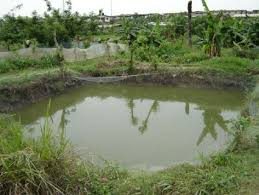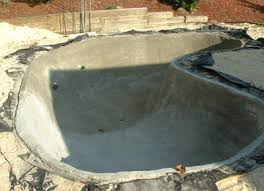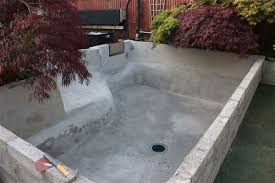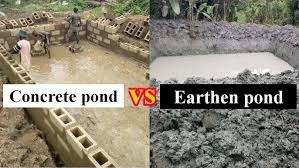Ponds are vital components in aquaculture, agriculture, and landscape design, serving various purposes such as irrigation, fish farming, recreation, and wildlife habitat. Two common types of ponds are earthen ponds and concrete ponds, each offering distinct characteristics, advantages, and limitations. Understanding these differences is crucial for selecting the appropriate pond type based on specific needs, environmental conditions, and intended use.
Earthen ponds, as the name suggests, are constructed using natural soil materials. They are typically excavated from the ground and lined with compacted soil to retain water. These ponds can vary in size and shape, adapting to the available land and desired water body dimensions. Earthen ponds are often preferred for their cost-effectiveness, especially in rural areas where soil materials are readily available.
They can be used for a variety of purposes, including fish farming, irrigation, and habitat for wildlife. The natural environment of earthen ponds often promotes biodiversity, as they can support various plant and animal species.
One of the primary advantages of earthen ponds is their ability to maintain a balanced ecosystem. The natural soil allows for the growth of aquatic plants, which provide oxygen and food for fish and other aquatic life. Additionally, earthen ponds can help in natural filtration, reducing the need for artificial water treatments.
However, they also have limitations, such as susceptibility to erosion, sedimentation, and fluctuations in water quality due to environmental factors. These issues can impact fish health and growth, making management crucial for successful aquaculture.
In contrast, concrete ponds are constructed using reinforced concrete, which provides a more durable and controlled environment for aquatic life. These ponds are often used in urban settings, research facilities, or commercial aquaculture operations where precise management of water quality and fish health is essential.
Concrete ponds can be built in various shapes and sizes, allowing for tailored designs that meet specific operational needs. The smooth, hard surfaces of concrete ponds help reduce the growth of algae and other unwanted vegetation, simplifying maintenance.
One significant benefit of concrete ponds is their longevity and resistance to environmental degradation. Unlike earthen ponds, which may require regular maintenance to prevent erosion and sediment buildup, concrete ponds generally require less upkeep over time.
They also provide better control over water quality parameters, such as pH and temperature, allowing for optimized conditions for fish production. However, the initial construction costs of concrete ponds can be significantly higher than those of earthen ponds, potentially making them less accessible for small-scale farmers or hobbyists.
Despite their advantages, concrete ponds can create challenges in terms of ecology. The lack of natural vegetation may lead to a less diverse ecosystem, limiting the habitat for some species. Furthermore, the rigid structure of concrete can make it difficult for certain fish species to thrive, as they often prefer environments with vegetation for cover and breeding.
Consequently, the choice between earthen and concrete ponds hinges on various factors, including the intended use, environmental conditions, available resources, and long-term management goals.
Definition of Earthen Ponds
Earthen ponds are natural or artificially created bodies of water formed by excavating soil to create a basin. They are typically lined with compacted soil or clay to retain water, making them suitable for aquaculture, irrigation, and recreational purposes.
Earthen ponds are often used for raising fish, shrimp, and other aquatic organisms, as they provide a habitat that mimics natural environments. The design and size of earthen ponds can vary widely, depending on their intended use and local environmental conditions.
Definition of Concrete Ponds
Concrete ponds are man-made water bodies constructed using concrete as the primary material for the walls and bottom. They are designed to hold water for various purposes, including aquaculture, ornamental landscaping, and recreational activities.
Concrete ponds offer several advantages over earthen ponds, such as durability, ease of maintenance, and better control over water quality. Their smooth surfaces help prevent the growth of unwanted vegetation, making them ideal for applications where cleanliness and aesthetics are a priority.
Construction Methods of Earthen Ponds

The construction of earthen ponds involves several steps to ensure proper design, water retention, and functionality. Here’s a step-by-step guide to constructing earthen ponds:
1. Site Selection: Choose an appropriate location that has good drainage and is away from potential sources of pollution. Ensure there is enough space for the desired size of the pond and consider factors like sunlight exposure and wind protection.
2. Designing the Pond: Plan the pond’s size and shape based on its intended use. Consider the depth, side slopes, and any necessary features like inflow and outflow points for water management.
3. Excavation: Use heavy machinery, such as excavators or bulldozers, to dig the pond according to the design specifications. Remove all vegetation, rocks, and debris from the excavation site to create a clean basin.
4. Compacting the Soil: To ensure water retention, compact the soil at the bottom and sides of the pond. This process helps reduce permeability and prevents water loss. Clay or clay-rich soil is often preferred for better sealing.
5. Creating Inlets and Outlets: Install water inlet and outlet structures to manage water flow in and out of the pond. These structures can be made from pipes or other materials and should be placed at appropriate locations to avoid erosion.
6. Filling the Pond: Once excavation is complete, allow the pond to fill with water, either from rainfall, groundwater, or a nearby water source. Monitor the water level to ensure proper filling and retention.
7. Vegetation and Habitat Creation: Add native plants around the pond’s edge to stabilize the soil, prevent erosion, and provide habitat for wildlife. These plants also enhance the ecological balance of the pond.
8. Regular Maintenance: After construction, maintain the pond by checking water levels, managing vegetation, and ensuring that the inlet and outlet structures function properly. Regular inspections help prevent problems such as sediment buildup or erosion.
Read Also: Chinchilla Endangered Rodent
Construction Methods of Concrete Ponds

Constructing a concrete pond involves several steps to ensure a durable and functional water body. Here’s a detailed guide to the construction methods:
1. Site Selection: Choose a location that is easily accessible and suitable for a pond. Ensure the area has good drainage and is away from potential sources of pollution.
2. Designing the Pond: Create a design plan that outlines the pond’s dimensions, shape, and features such as depth, water inlet/outlet points, and any aesthetic elements like benches or landscaping.
3. Excavation: Excavate the site according to the design specifications. This includes digging out the area where the pond will be built and ensuring the ground is level.
4. Building the Frame: Construct a framework using wood, steel, or metal that outlines the shape and size of the pond. This framework will hold the concrete in place during the pouring process.
5. Preparing the Base: Ensure the base is clean and level. Lay down a gravel base or compact the soil to provide a solid foundation for the concrete.
6. Reinforcement: Install steel reinforcement bars (rebar) in the frame to provide structural strength to the concrete. The rebar should be placed according to engineering guidelines, ensuring it is properly tied together.
7. Pouring the Concrete: Mix and pour the concrete into the framework, ensuring it fills all corners and edges. Use a vibratory tool to eliminate air bubbles and ensure an even distribution of the concrete.
8. Finishing the Surface: Once the concrete is poured, finish the surface with tools to achieve a smooth or textured finish, depending on the desired aesthetic. This step can include troweling or using a broom finish for traction.
9. Curing the Concrete: Allow the concrete to cure properly by keeping it moist for a specified period (usually 7 to 14 days). This is crucial for achieving the full strength and durability of the concrete.
10. Sealing the Concrete: After curing, apply a sealant to the concrete to enhance water resistance and prevent cracking. This step is vital for maintaining the longevity of the pond.
11. Testing and Filling: Once the pond is complete, test for any leaks. If the pond holds water, proceed to fill it and add any desired aquatic plants or fish.
Cost Comparison: Earthen vs. Concrete Ponds
| Cost Factor | Earthen Ponds | Concrete Ponds |
|---|---|---|
| Initial Construction Cost | Lower initial costs due to less expensive materials (soil, labor) | Higher initial costs due to materials (concrete, reinforcements) and specialized labor |
| Maintenance Costs | Moderate; may require periodic repair and erosion control | Higher; requires regular maintenance to prevent cracking and ensure sealing |
| Lifespan | Typically shorter lifespan (5-15 years) depending on soil erosion | Longer lifespan (20+ years) if properly maintained |
| Water Quality Management | Potentially lower costs due to natural filtration but can incur costs from erosion and sediment management | Higher costs due to chemical treatments and monitoring of water quality |
| Environmental Impact Costs | May require investment in erosion control and habitat restoration | May require investments in preventing chemical leaching and ensuring ecosystem balance |
| Operational Costs | Generally lower for water management; may need additional water supply during dry seasons | Potentially higher due to controlled water systems and equipment |
| Insurance and Liability | Lower premiums; less liability associated with natural structures | Higher premiums due to increased liability and structural integrity concerns |
Maintenance Requirements for Earthen Ponds
Maintaining earthen ponds is essential to ensure their longevity and productivity. Here are the key maintenance tasks:
1. Regular Inspections: Periodically check the pond for signs of erosion, sediment buildup, and vegetation overgrowth. Address issues as soon as they arise.
2. Erosion Control: Implement measures to prevent erosion, such as planting grass or installing silt fences along the banks. This helps stabilize the soil and reduce runoff.
3. Weed Management: Control aquatic weeds and unwanted vegetation through manual removal or the use of herbicides. Regular maintenance can prevent these plants from dominating the ecosystem.
4. Water Quality Monitoring: Regularly test water quality for pH, ammonia, nitrate levels, and dissolved oxygen. This helps maintain a healthy environment for aquatic life.
5. Sediment Removal: Over time, sediment can accumulate in the pond, reducing water depth and quality. Periodic dredging or removal of sediment may be necessary to maintain proper conditions.
6. Repairs: Address any damage to the pond’s banks or structure promptly. This may involve reinforcing eroded areas or repairing any leaks.
Read Also: Powdery Scab (Potatoes): Description, Damages Caused, Control and Preventive Measures
Maintenance Requirements for Concrete Ponds

Maintaining concrete ponds is crucial to ensure they remain functional and aesthetically pleasing. Key maintenance tasks include:
1. Regular Cleaning: Remove debris, leaves, and algae from the pond’s surface and sides regularly. This prevents buildup that can affect water quality.
2. Water Quality Testing: Monitor water quality consistently, checking parameters like pH, hardness, and clarity. Regular testing helps maintain a healthy aquatic environment.
3. Inspecting for Cracks: Periodically inspect the concrete for cracks or damage. Address any issues promptly to prevent water leaks and maintain structural integrity.
4. Sealing: Apply a sealant every few years to protect the concrete from water damage and reduce algae growth. Sealing also enhances the durability of the pond.
5. Managing Water Levels: Ensure proper water levels in the pond. Top off the water as needed, especially in hot weather when evaporation rates may increase.
6. Equipment Maintenance: If using pumps, filters, or other equipment, maintain and service them regularly to ensure optimal performance.
Environmental Impact of Earthen Ponds
Earthen ponds can significantly affect the environment, both positively and negatively. Here are some key impacts:
1. Ecosystem Support: Earthen ponds provide habitats for various aquatic species, including fish, amphibians, and insects. This biodiversity can enhance local ecosystems and support food webs.
2. Natural Filtration: The soil in earthen ponds can naturally filter pollutants and sediments, improving water quality over time. This helps maintain cleaner water, benefiting the surrounding environment.
3. Erosion and Sedimentation: Without proper management, earthen ponds can suffer from erosion, leading to sediment runoff into nearby waterways. This can degrade water quality and harm aquatic habitats.
4. Water Retention: Earthen ponds can help retain water in the landscape, reducing surface runoff and promoting groundwater recharge. This can be beneficial during dry periods.
5. Chemical Runoff: If fertilizers or pesticides are used in nearby agricultural activities, there is a risk of chemical runoff entering earthen ponds, which can harm aquatic life and degrade water quality.
6. Invasive Species: Earthen ponds may unintentionally support the growth of invasive species, which can outcompete native species and disrupt local ecosystems.
Environmental Impact of Concrete Ponds
Concrete ponds also have distinct environmental impacts, including:
1. Reduced Habitat Diversity: Unlike earthen ponds, concrete ponds often have less vegetation and habitat variety. This can limit the range of species that can thrive in these environments.
2. Water Quality Control: Concrete ponds can better control water quality due to their impermeable surfaces, reducing contamination from soil and minimizing sedimentation.
3. Chemical Leaching: Concrete can leach chemicals into the water, especially if not properly sealed. This may harm aquatic life and affect water quality.
4. Water Temperature Regulation: The solid structure of concrete can cause water temperatures to rise faster than in earthen ponds, potentially impacting fish and plant species sensitive to temperature changes.
5. Maintenance Needs: The maintenance of concrete ponds may involve the use of chemicals for cleaning and algae control, which can have negative environmental effects if not managed properly.
6. Runoff Management: Concrete ponds are typically designed with drainage systems that can manage runoff more effectively, preventing flooding and erosion in surrounding areas.
Do you have any questions, suggestions, or contributions? If so, please feel free to use the comment box below to share your thoughts. We also encourage you to kindly share this information with others who might benefit from it. Since we can’t reach everyone at once, we truly appreciate your help in spreading the word. Thank you so much for your support and for sharing!
Read Also: How to Start an Urban Farm

